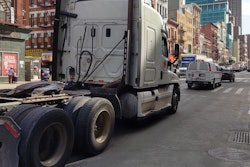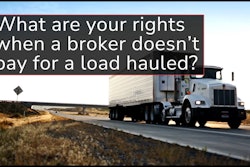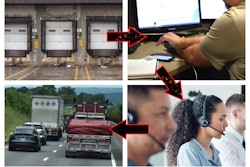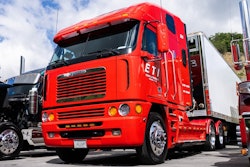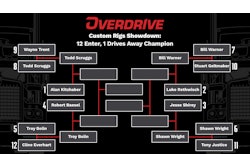For an owner-operator intending to secure freight from brokers or direct customers independent of another trucking company, motor carrier authority is a must. Follow the general filing steps noted below to obtain authority.
With the Federal Motor Carrier Safety Administration in the midst of an overhaul of its registration system in response to an uptick in identity and other fraud, however, know that some technicalities of the process could be changing. Generally, federal filing information and forms are available via the Registration section of FMCSA.DOT.gov.
Get USDOT number. Traditionally, there was no fee to register for your U.S. Department of Transportation number. Yet as of 2016, FMCSA’s Unified Registration System moved the $300 filing fee previously associated with MC numbers to the DOT number. For this filing, FMCSA’s online system will guide you through the process. (Several companies offer assistance in getting authority, from various factoring companies to DOT compliance specialists and the like.)
Get insurance. Pricing primary liability insurance can be done at any point. After filing your business type with your state, a general rule of thumb is to get quotes from different insurance companies to assess affordability.

Owner-operators who’ve made the move relatively recently toward their own authority report wildly varying quotes -- from $8,000 to $20,000 or more annually. Regardless of your driving record, as a new business you’re viewed as risky, and you’ll pay accordingly. Owners have reported primary liability rates falling to between $5,000 and $10,000 annually as their businesses became established, though rates have risen in recent years. Once insurance is secured, have the agent file the appropriate BMC-91 form with FMCSA as proof of insurance.
Designate process agent. The process agent you select will be the entity upon whom court papers may be served in any proceeding against your business. The process agent you select will use FMCSA’s form BOC-3 to make the designation. Make certain the agent is authorized to cover you in every state in which you operate.
The Owner-Operator Independent Drivers Association functions as the process agent for many of its members; some factoring companies also offer this service.
Process agents may charge a startup fee and cost around $100 annually. FMCSA maintains a list of process agents on the Registration and Licensing portion of its website.
[Related: FMCSA authority revocation anomaly: BOC3 blanket companies cleared out]
Complete UCR. Complete your Unified Carrier Registration via the central hub at plan.UCR.gov. The fee is $46 annually for carriers with one or two trucks, rising from there for more power units.
Do truck signage. Federal regulations require any truck to have the following on both sides in a highly contrasting color:
- The legal name of the motor carrier operating the truck as listed in the authority filing and on form MCS-150
- The USDOT number issued by FMCSA, preceded by the letters USDOT
If you want to include your name or any other name that differs from the exact business name, the words “operated by” must precede the legal name and identifying DOT number.
Other necessary filings
Heavy Highway Vehicle Use Tax (Form 2290) and International Registration Plan (IRP). If you are obtaining plates in your base state, you’ll need proof of payment of the annual federal HHVUT, which varies according to weight under load.
State fuel taxes. For more on the International Fuel Tax Agreement, find information in this story. As also noted in the Business Management section of the Partners in Business playbook, you must get your own IFTA account with your state to do your own fuel tax reporting, whether you do it yourself or through a third party. You do not have to have your own operating authority to get an IFTA account, but independent owner-operators must have such an account in their base plate state and be responsible for quarterly reporting.
State use taxes. Connecticut, Oregon, Kentucky, New Mexico and New York also levy separate use taxes you’ll need to track. Oregon requires monthly in-state mileage reporting, Kentucky and New Mexico quarterly.
[Related: IFTA primer for owner-operators new to the business]
Ways to avoid mistakes, future headaches when making the authority application
Before applying for motor carrier authority, understand that some of the most insignificant or otherwise minor-seeming errors can cause some of the longest delays in getting your “Operating Status” in FMCSA's registration system all the way to “Authorized for Property” (the most common authorized status for over-the-road operations). Until the authorized status is achieved, you are not compliant and as such cannot begin operations.
That is to say, you can’t haul loads and generate income independent of another motor carrier.
U.S. Army vets note an old saying that applies to the authority application process: fast is slow and slow is fast. When we do things in haste, mistakes happen. Online forms like those in the FMCSA's URS, can encourage haste. Always review every entry for typos, accuracy and duplications.
Typos -- These are the most common errors owner-operators make. Some are simple to see and identify, while others are more difficult to spot. 1) Misspelling: Auto-correct can be your worst enemy. Always verify the spelling of every entry before moving on to the next field. 2) Punctuation: Whether or not a comma, period, hyphen, etc. is or isn’t present can cause serious headaches. 3) Spaces: A missing or extra space between words or letters can be very difficult to locate.
Accuracy -- Such errors represent the second-most-common errors for new owners, and can be time-consuming and downright aggravating to correct. An accuracy error may be an honest mistake or a misunderstanding of what is being asked on the application. In the worst cases, an accuracy error could be viewed as a willful deception. Never be deceptive on your authority filing. It's bound to increase your insurance premium and can potentially be a compliance violation. Since accuracy relates to every entry and selection you make, be sure to go slow and double-check your work:
Entity Type: “Motor Carrier of Property (except Household Goods)” is the most common entity type for owner-operators. Occasionally an applicant who is hauling new furniture from a manufacture to a warehouse will incorrectly believe this means they are a “Motor Carrier of Household Goods (Moving Companies)” and select the wrong entity type. Be sure to know which entity type is correct for your operation before beginning the application.
DBA (Doing Business As): This is the most frequent accuracy error and comes in many forms. The best way to avoid DBA errors is not to use a DBA alternate name for your business. That said, here are three common DBA errors:
**A DBA name should never be exactly the same as the company name. If they are the same name, some insurance companies will not even provide an insurance quote, according to agents.
**The DBA should never be a second corporation. If your authority is filed as "Tom Harry, Inc.," and you add a DBA name of “Harry's Express, Inc." it suggests two separate corporations are attempting to use the same USDOT and/or MC number.
**Never enter “same,” “same as company name,” “none,” “N/A,” or any other variation for a DBA name. If you are not using a DBA, the field must be left blank. Any entry you put in the DBA field becomes your “Doing Business As” name.
Company Address: A motor carrier's principal place of business address in the authority application is the legal address for the company, where all required company records and FMCSA-required verifying documents are to be stored, maintained and ready for inspection. It's also where deception has most often been uncovered, particularly in the case of double-brokering entities filing for authority and attempting to avoid scrutiny from authorities by using virtual offices, a P.O. box address and/or other addresses. Never use a virtual or alternate address as a company address.
[Related: Don't be lured into dishonesty in attempts to reduce your trucking insurance premium]
Mailing Address: Only use a different mailing address if you use a USPS P.O. Box, local UPS Store box, etc., for crucial mail delivery. Otherwise, you appear to be hiding something or potentially attempting to "reincarnate" another business as a chameleon carrier, especially if you are using an out-of-state mailing address.
Hazmat: For auto transporters, this is a common error type -- and for those who only haul cars and and those who haul them occasionally. Autos are Class 9 Hazmat, which does not require placards but does require more than the standard minimum $750,000 in Bodily Injury Property Damage (BIPD) auto liability insurance filings when operating over 26,000 lbs. Auto transporters, even those who only haul cars two or three times a year, are required to declare Class 9 Hazmat and have $1,000,000 in BIPD auto liability insurance.
Generally, when making the authority application, carefully read instructions and verify your entry(s).
Some find it helpful to have a few things written down or in a document on their computer before beginning:
- Company name with correct spelling and punctuation
- If one is desired, a company DBA
- Company address (and mailing address if different)
- Commodities (cargo) intended to haul
**Identify any possible Hazmat. Both those that require placards and those that do not (Class 9).
**Choose more than general freight from the list provided by the FMCSA.
**If necessary, using the “other” option, specify any type of unique or special cargo that does not adequately fit into one of the choices provided.
[Related: Get your own authority: How to tackle to basics of filing, insurance, more]
Read next: Going independent: Motor carrier authority brings risks, rewards



